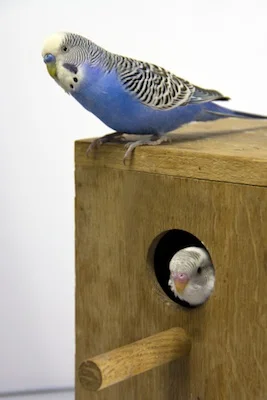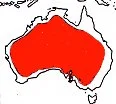Budgerigars are small birds.
They are different colours.
They make a chirping noise.
Some copy words that people say.
Some budgies are wild and some are pets.
Budgerigars are small members of the parrot family. They are one of the most popular pets around the world, and are most often known as budgies.
Budgerigars in the wild
Budgerigars in the wild. © Getty Images
Budgerigars are native to Australia, where they can be found living in groups called flocks in many parts of the country. They are nomadic, which means that, rather than stay in one area, they fly from place to place wherever there is available food and water. They feed on insects, grains and seeds.
They prefer open areas like grasslands and woodlands in dryer parts of Australia.
Where budgerigars are found in the wild.
Their main natural predators are snakes and birds of prey. When a budgerigar flock is flying, the birds dart about fast, twisting and turning. This makes it harder for birds of prey to catch them in the air because it is hard to predict where they'll move.
A group of budgerigars is called a chatter or flock.
However, pet budgies are bred in captivity and bought from pet shops, not taken from the wild. Budgerigar breeders have developed many more colours than the original wild birds, and around 32 colour variations are now found in captive birds.
Appearance and Behaviours
Wild budgerigars nest in tree hollows. ©Getty Images
Budgerigars are about 18 cm long, with slender bodies and long tails. Wild budgerigars have green, black and yellow feathers. Their backs and wings, called the mantle, have black markings. These markings make them hard to see from above, providing camouflage in the wild when they are on the ground feeding.
Adults have yellow faces, and some have purple patches on their cheeks. Budgies have a long tail of dark blue, but when they are flying, the yellow outside of the feathers can be seen.
Budgerigars are the only birds that have the first and fourth toes facing backwards, while the second and third face forwards. This helps them climb well and perch comfortably.
Budgies also have a special feature in being able to see ultra violet light. This means that some of their markings glow and attract attention, which is how male budgerigars attract females.
The upper part of a budgie's beak is strong and smooth, larger than the bottom part. Their beaks are always growing, so they need to chew or shred things to keep them from getting too big.
Adult males have a blue cere above the beak. ©Getty Images
At the top of the beak is the part where the nostrils are, and it is called the cere (rhymes with ear). Males have a blue cere, breeding females have brown. Females that are not breeding have a pale brown or white cere, and young ones have pink.
Budgerigars are playful and curious. They are very smart, and tame budgies easily learn to sit on a person's hand or finger. They will copy sounds and words that are repeated to it.
Life Cycle
Unlike most birds, budgies don't make nests. In the wild, female budgerigars lay their eggs in hollows in trees, and in captivity in a nesting box. The female begins to lay eggs about a week after mating with a male. She lays from four to six eggs.
A budgie chick © Getty Images
The female incubates the eggs by sitting on them to keep them warm. The eggs hatch after about eighteen days. The young are born without feathers and are blind. The female feeds her babies with partly digested food which she brings up from inside her body. After five weeks the young budgerigars have feathers and can fly and look after themselves.
Budgerigars as pets
Housing your pet budgerigar
Pet budgies lay their eggs in a nesting box. © Getty Images
Budgerigars like to fly and climb so they should be housed where they can do both. An aviary with wire walls on which they can climb and with space to fly is ideal. If the budgie is kept in a cage it should be in a place where the temperature is about the same at all times and away from draughts.
Tree branches and perches of natural wood in the aviary or cage will help the budgie keep its claws and beak trimmed.
Cuttlefish bone is also used by the bird to trim its beak.
Feeding your pet budgerigar
Pet shops sell a seed mix specially prepared for budgerigars. The birds should also be fed fresh fruit and vegetables such as apple, broccoli and green leafy vegetables.
Small toys and mirrors keep pet budgies entertained. Getty Images
However, do not feed your budgie cabbage, lettuce, potato, citrus fruit, plums, onion, chocolate. These foods can make your budgie sick.
The budgie should always have fresh drinking water and water in which to take a bath.
You can buy toys and mirrors at pet shops to put in the aviary for your pet budgie.
Be a responsible pet owner!
Pet budgerigars depend on their owners for food, protection and shelter. Before becoming a pet owner think carefully about all the things you will have to do to care for your pet responsibly.
It’s a good idea to find information from more than one source!
Read more about budgerigars:
https://www.animalfunfacts.net/parrots/142-budgie.html
Watch a video that shows the growth of a budgie hatchling and wild budgerigar habitats in Australia
https://www.youtube.com/watch?v=HuhGnL9kuJ8
Watch a video about pet budgies:
https://www.youtube.com/watch?v=VINpspvP1ZU








